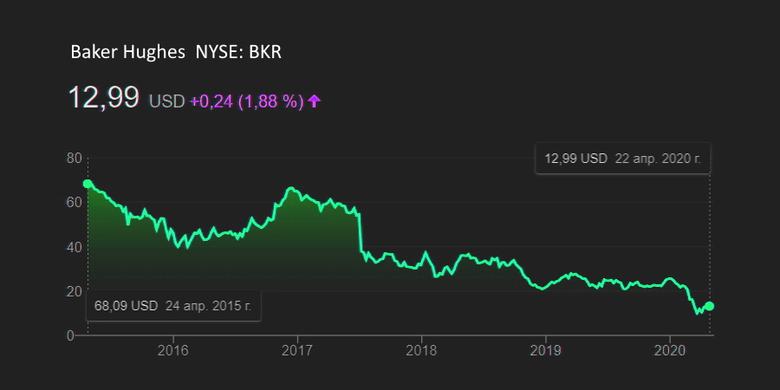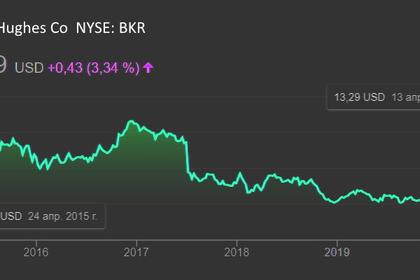
BAKER HUGHES NET LOSS $10 BLN

BAKER HUGHES - April 22, 2020 - Baker Hughes Company Announces First Quarter 2020 Results
- Orders of $5.5 billion for the quarter, down 20% sequentially and down 3% year-over-year
- Revenue of $5.4 billion for the quarter, down 15% sequentially and down 3% year-over-year
- GAAP operating loss of $16,059 million for the quarter, down sequentially and year-over-year
- Adjusted operating income (a non-GAAP measure) of $240 million for the quarter, down 56% sequentially and down 12% year-over-year
- GAAP diluted loss per share of $(15.64) for the quarter which included $15.75 per share of adjusting items. Adjusted diluted earnings per share (a non-GAAP measure) were $0.11.
- Cash flows generated from operating activities were $478 million for the quarter. Free cash flow (a non-GAAP measure) for the quarter was $152 million.
|
|
Three Months Ended |
|
Variance |
|||||||||||
|
(in millions except per share amounts) |
March 31, 2020 |
December 31, 2019 |
March 31, 2019 |
|
Sequential |
Year- over- year |
||||||||
|
Orders |
$ |
5,532 |
|
$ |
6,944 |
|
$ |
5,693 |
|
|
(20) |
% |
(3) |
% |
|
Revenue |
5,425 |
|
6,347 |
|
5,615 |
|
|
(15) |
% |
(3) |
% |
|||
|
Operating income (loss) |
(16,059) |
|
331 |
|
176 |
|
|
U |
|
U |
|
|||
|
Adjusted operating income (non-GAAP) |
240 |
|
546 |
|
273 |
|
|
(56) |
% |
(12) |
% |
|||
|
Net income (loss) attributable to Baker Hughes |
(10,210) |
|
48 |
|
32 |
|
|
U |
|
U |
|
|||
|
Adjusted net income (non-GAAP) attributable to Baker Hughes |
70 |
|
179 |
|
76 |
|
|
(61) |
% |
(8) |
% |
|||
|
EPS attributable to Class A shareholders |
(15.64) |
|
0.07 |
|
0.06 |
|
|
U |
|
U |
|
|||
|
Adjusted EPS (non-GAAP) attributable to Class A shareholders |
0.11 |
|
0.27 |
|
0.15 |
|
|
(59) |
% |
(27) |
% |
|||
|
Cash flow from operating activities |
478 |
|
1,357 |
|
(184) |
|
|
(65) |
% |
F |
|
|||
|
Free cash flow (non-GAAP) |
152 |
|
1,053 |
|
(419) |
|
|
(86) |
% |
F |
|
|||
|
"F" is used in most instances when variance is above 100%. Additionally, "U" is used in most instances when variance is below (100)%. |
“Despite a volatile macro environment driven by a significant decline in oil prices and the COVID-19 pandemic, we produced solid results in our Turbomachinery & Process Solutions (TPS) and Oilfield Services (OFS) businesses and generated over $150 million of free cash flow despite typical seasonal headwinds in the first quarter. The strength of our Company and diversity of our portfolio are most apparent in times like these. Our coordinated crisis response, continued execution for customers and shareholders, and strong balance sheet all reflect the best of Baker Hughes. I am extremely proud of our team for their focus and perseverance through an extraordinary set of circumstances,” said Lorenzo Simonelli, Baker Hughes Chairman and Chief Executive Officer.
“During the first quarter, the macro environment changed rapidly. The sudden demand shock from COVID-19 combined with rising global oil supply drove a 67% decline in oil prices during the first quarter. Looking forward, the outlook for oil and gas demand and supply appears equally uncertain, and it will largely be driven by the pace of economic recovery from the COVID-19 pandemic and the supply response that ultimately materializes.
“To navigate this challenging environment, we have taken decisive actions in an effort to cut costs, accelerate structural changes, and deploy technology and optimize processes that can lower costs for our customers. This includes reducing capital expenditures by more than 20% versus 2019, executing a restructuring plan to right size our operations for anticipated activity levels and market conditions, as well as continuing to deliver on our portfolio evolution strategy. While accelerated, these actions are in line with broader changes that we outlined previously to improve margins and operating efficiency.
“As we look forward, Baker Hughes’ portfolio remains uniquely positioned to navigate the challenging market environment. Our strong backlog of longer-cycle projects and aftermarket services provides greater stability as our shorter-cycle businesses encounter pressure from the dramatic declines in activity. We remain committed to delivering critical technology that helps our customers operate more efficiently, lowering their cost and improving their outcomes,” concluded Simonelli.
-----
Earlier:









